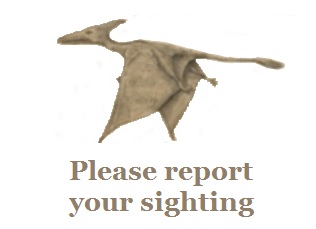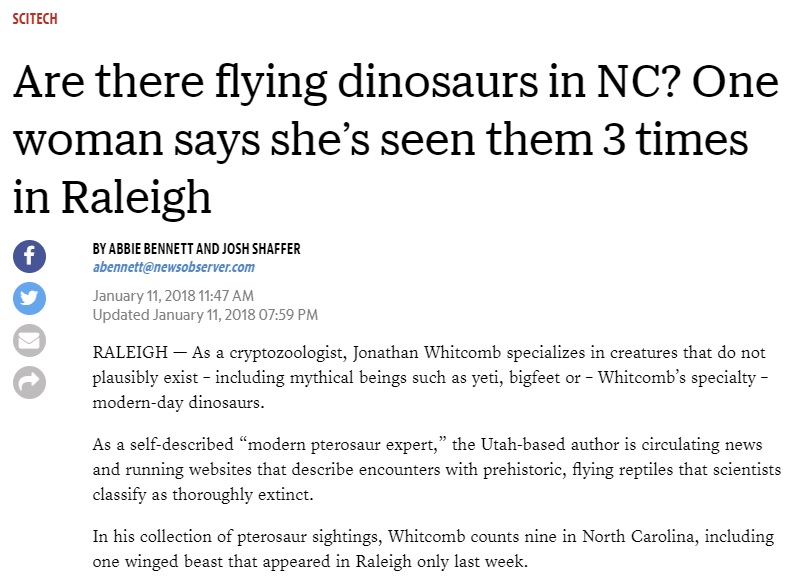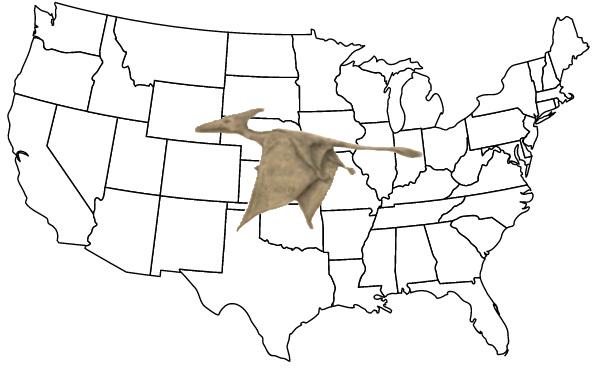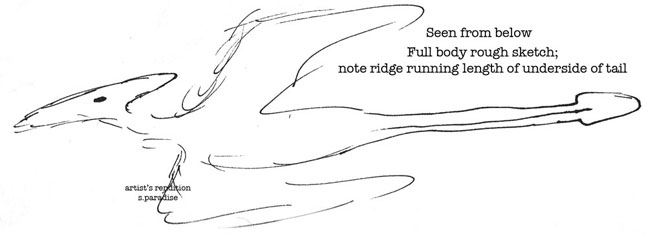By the modern-pterosaur investigator Jonathan Whitcomb
Some of the eyewitness reports that I receive come from encounters years earlier, sometimes even decades earlier. Let’s now look at four accounts of sightings that were reported to me within the past few weeks, regardless of when the encounter took place.
Since the word “dinosaur” is mentioned in one of these, let’s be clear about it. In a scientific or technical sense, pterosaurs (aka “pterodactyls” by non-scientists) and not dinosaurs. Many people associate them with dinosaurs because of the popular idea that they lived together many millions of years ago. In reality, pterosaurs and dinosaurs are two distinct types of animals, regardless of when people believe that they lived.
.
Sighting in California, S.F. Bay area
I got the following in January of 2018, a few days after the sighting:
Fremont, CA – 1/14/2018 – around 10pm PST
I witnessed a pterodactyl from roughly 50-75 feet away. It was gliding steadily, without flapping its wings, seemingly meer [mere] feet above the rooftop of an adjacent building. Wingspan, estimated 12 ft., distinctly visible diamond shape at end of tail. Crown of head tough to make out behind wing at angle of sight.
The eyewitness replied to my questions and indicated the tail was long.
.
Sighting in Illinois
In 2007 at around 3 pm
Somewhere between Schaumburg and Elgin IL while driving west on I-90 at 55 mph for 4-6 seconds I saw a flying creature that didn’t make any sense. The animal was black but in the bright sunlight I could make out wrinkles or texture on the surface or the wings. I often take a minute to admire the golden eagles that circle the highway. This creature caught my attention because the size and shape of the wings which looked more like bat wings than bird wings. There were no feathers and the creature had a long spiked tail. I couldn’t place what I was looking at. It was no bird I could identify. I watched this creature travel southeast toward Busse woods.
.
Sighting in Southern California
On January 31 2018 at 6:25 pm I watched a very large creature fly from west to east over Eastern Anaheim California. At first I thought this was an airplane of some sort or another. However shortly after sunset any aircraft would have exterior lights and make an engine noise. This was totally silent and gliding on very mild breeze of maybe 4-5 miles an hour. As I sat on my front porch looking west and talking on the phone, I saw this creature in flight it appeared to be off white or a pale green. From my vantage point I could see that the creature was about 400 to 600 feet above the ground and about 25 to 30 foot wingspan. I even thought it could be a remote control until it flapped its wings and then I was sure I was witnessing something very special indeed.
.
Sighting in the Philippines
Its already 2018 when I saw this article and im really curious about it when I read that there are sightings in the Philippines (Pagbilao, Quezon). I have a same experience when I was a child (I really dont remember what specific year it is, approximately it is between 1995-1998) and we are having a vacation in my grandfather’s house in San Antonio, Quezon Province, Philippines. I saw a bat-like flying creature in the ceiling of the house in the 2nd floor, no feathers, almost skinny like a bat, not too dark skin color brown as I remember and its beak is so long and have one horn directly opposite to its beak at the back of its head and I really think it is a dinosaur or somehow a surviving remnants of pterodactyl. And maybe I was child back then but I am aware of what is a bat looks like and it is not a bat, also im aware of dinosaurs. My father told me to just ignore it so I really dont know what happened to the creature afterwards because when I look for it, it already flew away. I wont forget about that day because there is an old movie here in the Philippines titled “Anak ng Bulkan” and I believe that it might be true that there are still remnants of the pre-historic creature back then.
If you have seen anything that might have been a living pterosaur, please report it to me.
.
###
.
Dos estadounidenses han visto un pterosaurio vivo en Cuba: Patty Carson y Eskin Kuhn.
.
Living pterosaurs in California
A “pterodactyl” or pterosaur has also been reported from other parts of Los Angeles County: San Fernando Valley, Altadena, and twice in the Santa Fe Springs area.
.
Another Living Pterosaur in North Carolina
. . . two of my friends saw one at different times in NC, Durham. I was alone driving my car, and looked out my sunroof to see what I think was a pterodactyl.
.
Modern pterosaur in Philippines
At least a few eyewitnesses in the Philippines have reported pterosaur sightings to at least one cryptozoologist; I (Jonathan Whitcomb) have received a few reports myself.
.
This report of an encounter in the Anza-Borrego Desert State Park is found in the second chapter of the book [Live Pterosaurs in America]
.
Living pterosaurs and frigatebird misidentification
The great majority of those reports were of flying creatures that could not reasonably be attributed to misidentified frigatebirds, for a number of reasons.
.







